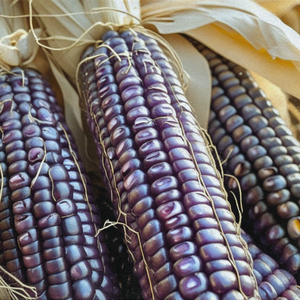- Hardiness Zone: 3-7 Annual
Seed Depth: 1–1 ½ inches
Seed Spacing: 8–12 inches
Row Spacing: 30–36 inches
Sunlight: Full sun
Days to Sprout: 7–10 days
Days to Maturity: 100–110 days
Growth Habit: Tall, upright stalks with large ears
Sunlight: Requires full sun for strong growth and ear development.
Soil Type: Prefers fertile, well-drained soil with added compost; avoid compacted soils.
When to Plant: Sow outdoors in late spring after soil has warmed to at least 60°F.
Direct Sowing: Plant seeds 1–1 ½ inches deep, 8–12 inches apart, in rows spaced 30–36 inches. For best pollination, plant in blocks of at least 4 short rows rather than one long row.
Indoor Sowing: Not recommended — corn performs best when directly seeded outdoors.
Succession Planting: For a steady harvest, stagger plantings every 2–3 weeks until midsummer.
Watering: Provide consistent moisture, especially during tasseling and ear development. Avoid letting soil dry out.
Weeding: Keep soil weed-free early in the season to reduce competition.
Fertilizing: Heavy feeder — amend soil with compost before planting and side-dress with nitrogen as plants grow.
Mulching: Use mulch to retain soil moisture and suppress weeds.
Support: Tall stalks may benefit from hilling soil around the base for stability.
When to Harvest: Pick ears for roasting when kernels are plump and milky, or leave until husks are dry and papery for flour and meal.
How to Harvest: Twist ears downward to remove from stalks.
Storing for Eating: For flour or meal, dry kernels thoroughly on the cob before shelling. Store dried kernels in a cool, dry location in an airtight container.
Allow to Mature: Leave ears on the stalk until husks are fully dry and brown.
Harvesting Seeds: Remove dried ears, shell kernels, and discard debris.
Isolation: To maintain variety purity, grow at least 500 feet away from other corn types.
Storage: Store kernels in an airtight container in a cool, dark, and dry place; viable for several years.
Why You’ll Love It
Historic Heirloom: An ancestral corn variety treasured by the Hopi people of the Southwest.
Striking Blue Kernels: Unique, deep indigo ears that stand out in the garden and kitchen.
Versatile Grain: Grind into flour for tortillas, bread, and cornbread, or use for roasting and decoration.
Resilient Grower: Heat- and drought-tolerant, making it an excellent choice for challenging climates.
Plant Characteristics
Height: 8–10 feet
Growth Habit: Tall, upright stalks with strong roots for wind resistance
Ear Type: 8–10 inch ears with deep blue to purple kernels
Days to Maturity: 100–110 days
Hardiness: Warm-season annual
Flavor and Culinary Uses
Flavor: Rich, nutty, and slightly sweet when roasted; hearty flavor when ground into flour
Culinary Uses: Traditionally used for tortillas, cornbread, tamales, and hominy
Companion Planting Tips
Good Companions: Beans, squash, sunflowers, and melons
Avoid Planting Near: Tomatoes and brassicas, which may compete for nutrients
Bonus Benefit: Works beautifully in Three Sisters planting with beans and squash
Common Issues and Solutions
Poor Pollination: Plant in blocks rather than single rows for fuller ears
Earworms: Apply mineral oil to silks or encourage beneficial insects
Lodging (Falling Stalks): Plant in protected areas or hill soil around stalk bases for stability
Seeds Per Packet
| 10g | Approximately 30 |
| 20g | Approximately 60 |
Why You’ll Love It
Historic Heirloom: An ancestral corn variety treasured by the Hopi people of the Southwest.
Striking Blue Kernels: Unique, deep indigo ears that stand out in the garden and kitchen.
Versatile Grain: Grind into flour for tortillas, bread, and cornbread, or use for roasting and decoration.
Resilient Grower: Heat- and drought-tolerant, making it an excellent choice for challenging climates.
Plant Characteristics
Height: 8–10 feet
Growth Habit: Tall, upright stalks with strong roots for wind resistance
Ear Type: 8–10 inch ears with deep blue to purple kernels
Days to Maturity: 100–110 days
Hardiness: Warm-season annual
Flavor and Culinary Uses
Flavor: Rich, nutty, and slightly sweet when roasted; hearty flavor when ground into flour
Culinary Uses: Traditionally used for tortillas, cornbread, tamales, and hominy
Companion Planting Tips
Good Companions: Beans, squash, sunflowers, and melons
Avoid Planting Near: Tomatoes and brassicas, which may compete for nutrients
Bonus Benefit: Works beautifully in Three Sisters planting with beans and squash
Common Issues and Solutions
Poor Pollination: Plant in blocks rather than single rows for fuller ears
Earworms: Apply mineral oil to silks or encourage beneficial insects
Lodging (Falling Stalks): Plant in protected areas or hill soil around stalk bases for stability
Seeds Per Packet
| 10g | Approximately 30 |
| 20g | Approximately 60 |




Share and get 15% off!
Simply share this product on one of the following social networks and you will unlock 15% off!